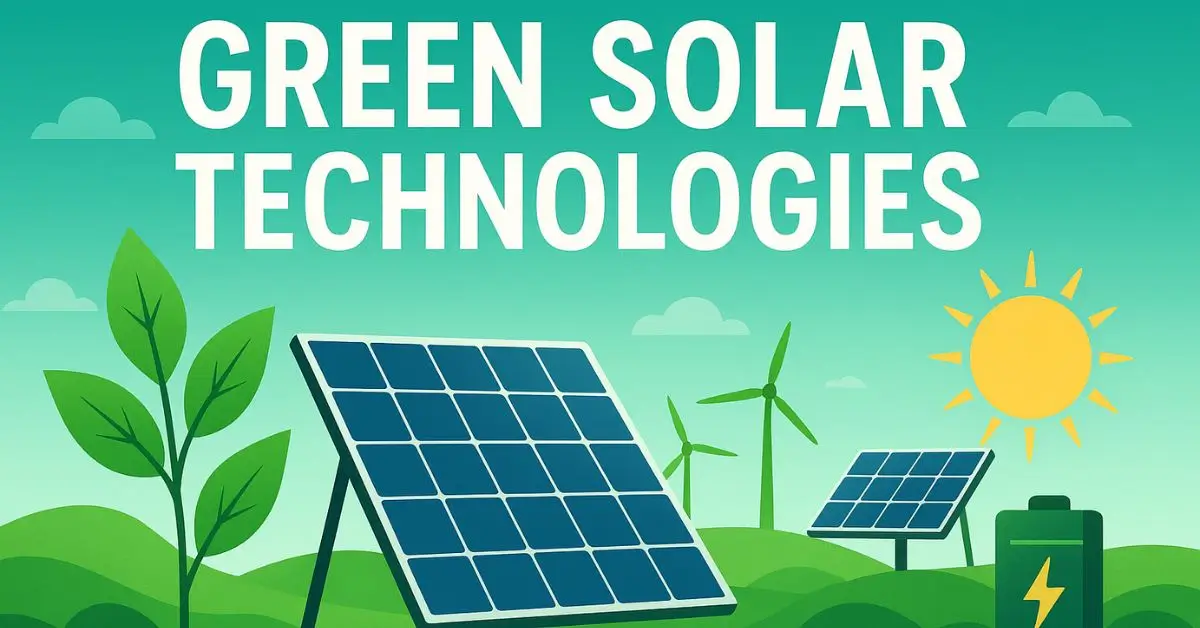In today’s world, energy isn’t just about keeping the lights on—it’s about keeping the planet alive. That’s where green solar technologies come in. They’re more than just solar panels on rooftops; they represent a smarter, cleaner way to power homes, cities, and industries.
Table of Contents
What Are Green Solar Technologies?
Green solar technologies are innovations that turn sunlight into electricity or heat without harming the environment. They include everything from photovoltaic (PV) panels and solar thermal systems to floating solar farms and solar-powered batteries.
In short, they’re all about using the free, endless power of the sun—while reducing greenhouse gas emissions and dependence on fossil fuels. (hstech.io)
How Solar Energy Became “Green”
Traditional solar systems were effective but not always eco-friendly to produce. Modern green solar technologies fix that problem.
Today’s panels are made with recyclable materials, employ non-toxic manufacturing processes, and achieve higher efficiency rates, meaning they generate more energy using fewer resources.
Even installation has gone green—thanks to lightweight flexible panels and mounting systems that minimize land use and habitat disruption.
Key Innovations in Green Solar Tech
Here are some groundbreaking advancements that are changing the game:
1. Bifacial Solar Panels
Unlike traditional panels that absorb light from one side, bifacial panels capture sunlight from both sides, allowing for increased energy production. They can boost energy output by up to 30%, making them ideal for open spaces and solar farms.
2. Perovskite Solar Cells
These new cells are cheaper and easier to produce than silicon ones, while maintaining impressive efficiency. Many experts call them the future of affordable solar energy.
3. Floating Solar Farms
Installing solar panels on lakes or reservoirs reduces land usage and keeps the panels cool, increasing their efficiency.
4. Solar Roof Tiles
Instead of bulky panels, solar tiles blend into roofs. They look stylish, generate power, and make solar adoption more appealing to homeowners.
5. Solar Energy Storage Systems
Energy storage is the missing piece in the renewable power puzzle. New battery technologies—such as lithium-iron-phosphate and solid-state batteries—are making solar power more reliable, even at night.
Nanotechnology Applications: 5 Top Fields Using This Powerful Tech
Environmental and Economic Benefits
Switching to green solar technologies brings a wave of benefits:
- Zero Emissions: Solar energy produces no carbon emissions once installed.
- Lower Costs: After setup, sunlight is free—reducing monthly energy bills dramatically.
- Job Creation: The global solar industry now employs millions in manufacturing, installation, and maintenance.
- Energy Independence: Countries and communities can generate their own power, reducing reliance on imported fuels.
- Sustainable Growth: Solar farms can coexist with agriculture (agrivoltaics), boosting food and energy production together.
Challenges Still Ahead
Even with all the progress, there are still hurdles to overcome:
- Initial Costs: The upfront price of panels and batteries can be high, though it’s dropping every year.
- Recycling: Managing old solar panels responsibly remains a growing concern.
- Weather Dependence: Energy production still relies on the availability of sunlight, requiring efficient storage systems.
The good news? Governments and tech companies are investing heavily to address these challenges through the development of better materials, smarter grids, and supportive policies.
The Future of Green Solar Technologies
The solar industry is evolving fast. Experts predict that by 2035, solar power could supply more than one-third of the world’s electricity. New technologies, such as solar paints, transparent panels, and AI-powered energy management systems, are already being tested and implemented.
It’s clear: solar energy isn’t just an alternative anymore—it’s the core of a sustainable energy revolution.
Final Thoughts
Green solar technologies aren’t just about panels and power—they’re about hope.
A hope that one day, the energy we use to light our homes and charge our devices won’t damage the planet that sustains us.
Every watt generated from the sun is a step closer to a cleaner, greener future. Technology Solutions Professional: Guide + 5 Key Responsibilities



